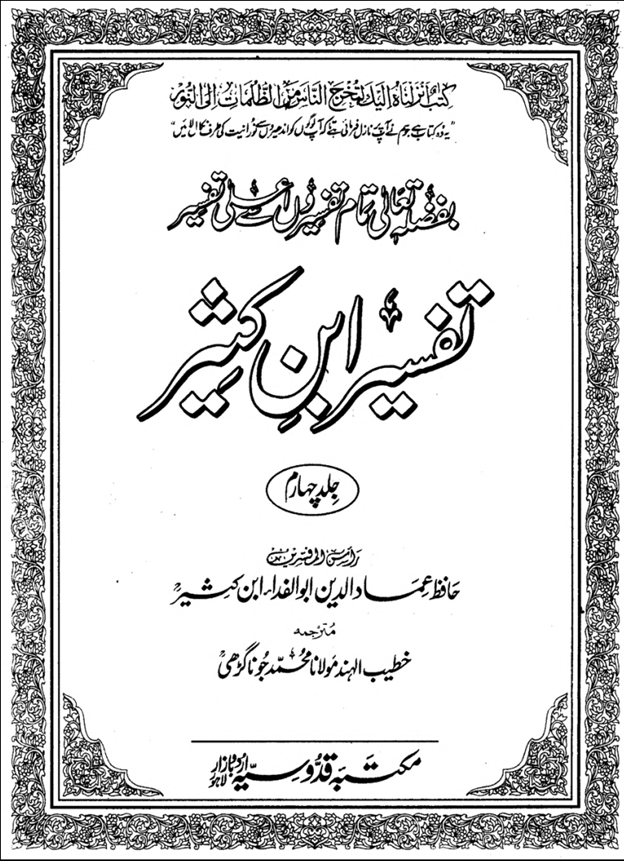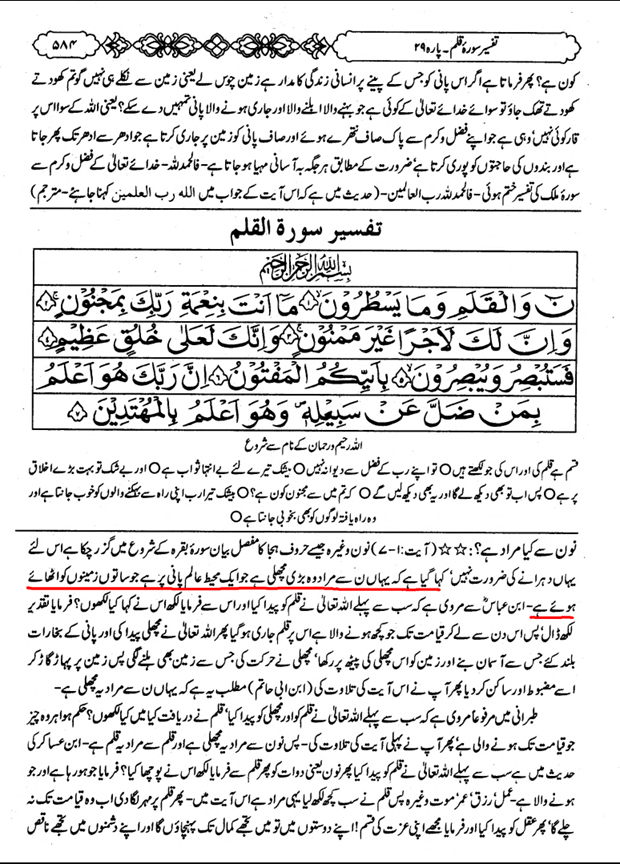In this post, we tear into a ridiculous cosmological model found in Tafsir Ibne Kathir, one of the most revered commentaries on the Quran in Islamic tradition. Written by Ibn Kathir in the 14th century and translated into Urdu by Maulana Muhammad Junahgarhi, this exegesis interprets the mysterious term “Nun” from Surah Qalam (Chapter 68) in a way that defies logic, science, and common sense. What we find is a bizarre stack of a giant fish, a massive rock, and a bull with forty thousand horns supposedly holding up the seven earths. Let’s dive into the text and expose its absurdity.
The Excerpts from Tafsir Ibne Kathir
Here are the exact quotes from the Urdu translation, along with their English translations, as presented in Tafsir Ibne Kathir – Urdu Translation by Khateeb Al Hind Maulana Muhammad Junahgarhi, Jild Number 4, Page no. 584, 585 (Tafsir of Surah Qalam).


Page 584:
Urdu Quote: یہاں نون سے مراد وہ بڑی مچھلی ہے جو ایک محیط عالم پانی پر ہے جو ساتوں زمینوں کو اٹھائے ہوئے ہے۔
English Translation: Here, “Nun” refers to that large fish which is on a vast water that encompasses the world, and it is holding the seven earths.
Page 585:
Arabic [Source]: وقال ابن أبي نجيح: إن إبراهيم بن أبي بكر أخبره عن مجاهد قال: كان يقال النون الحوت العظيم الذي تحت الأرض السابعة, وقد ذكر البغوي وجماعة من المفسرين أن على ظهر هذا الحوت صخرة سمكها كغلظ السموات والأرض, وعلى ظهرها ثور له أربعون ألف قرن وعلى متنه الأرضون السبع وما فيهن وما بينهن
Urdu Quote: نون سے مراد وہ مچھلی ہے جو ساتویں زمین کے نیچے ہے۔ بغوی وغیرہ مفسرین فرماتے ہیں کہ اس مچھلی کی پیٹھ پر ایک چٹان ہے جس کی موٹائی آسمان وزمین کے برابر ہے اس پر ایک بیل ہے جس کے چالیس ہزار سینگ ہیں اس کی پیٹھ پر ساتوں زمینیں اور ان پر تمام مخلوق ہے۔
English Translation: “Nun” refers to that fish which is below the seventh earth. Baghawi and other commentators say that on the back of this fish there is a rock whose thickness is equal to the heavens and the earth, and on that, there is a bull with forty thousand horns, and on its back are the seven earths and all the creation upon them.


Breaking Down the Nonsense
According to this interpretation, the universe is structured like some fantastical tower:
- At the bottom: A gigantic fish, floating on or in a vast water that supposedly surrounds everything.
- On the fish: A rock so thick it matches the combined size of the heavens and the earth.
- On the rock: A bull sporting an outrageous forty thousand horns.
- On the bull: The seven earths, with all their inhabitants and creation piled on top.
This isn’t a divine revelation—it’s a poorly constructed myth straight out of ancient folklore. The fish is described as being “below the seventh earth” yet somehow supports this entire cosmic stack, implying it’s the foundation of everything. The seven earths, presumably layered or spread out, rest on a bull, which stands on a rock, which sits on the fish—all of it floating in or on some enormous water. It’s a laughable image that collapses under the slightest scrutiny.

Why This Matters
This isn’t just some obscure footnote. Tafsir Ibne Kathir is a cornerstone of Islamic scholarship, widely respected and studied by Muslims worldwide. Yet here it is, peddling a view of the universe that’s as credible as a child’s bedtime story. Compare this to what we know today: the Earth is a spherical planet, orbiting the Sun in a vast, expanding universe governed by gravity and physics—not propped up by a fish and a bull. There’s no evidence for any of this—no fish, no rock, no forty-thousand-horned bull. It’s pure fantasy.
This cosmological model doesn’t stand alone either. It echoes myths from other cultures—like the Hindu idea of the world resting on elephants or turtles—suggesting that Islamic scholars simply recycled pre-existing fables and slapped a Quranic label on them. For a religion that claims its scripture is the ultimate truth, timeless and universal, this is a glaring embarrassment.
The Bigger Problem
The presence of such nonsense in a foundational Islamic text raises damning questions. How can a book supposedly revealed by an all-knowing God inspire interpretations so utterly detached from reality? If Tafsir Ibne Kathir can get something as basic as the structure of the universe this wrong, what else is unreliable? Defenders might argue it’s metaphorical or symbolic, but the text doesn’t read that way—it’s presented as a literal explanation, endorsed by scholars like Baghawi. Others might say it was just the science of the time, but that only proves the point: this is a human creation, limited by the ignorance of the 14th century, not a divine blueprint.
For a faith that insists the Quran is infallible, this is a disaster. It forces believers into a corner: either admit the text is wrong, reinterpret it beyond recognition, or cling to a delusion that defies all evidence. None of those options look good for a religion claiming ultimate authority.
Conclusion
The cosmological model in Tafsir Ibne Kathir isn’t just outdated—it’s absurd, unscientific, and a relic of primitive thinking. A giant fish supporting a rock, a bull, and seven earths? It’s the kind of story that belongs in ancient myths, not a serious religious commentary. That this appears in a text as prestigious as Tafsir Ibne Kathir exposes a deep flaw in Islamic tradition: its willingness to embrace and defend ideas that crumble under rational examination. If this is the best explanation Islamic scholarship can offer for the universe, it’s no wonder critics question the entire framework.
